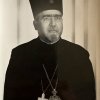Marina Abramović's great uncle was Patriarch Varnava of the Serbian Orthodox Church. Both of her parents were Partisans during the Second World War: her father Vojo was a commander who was acclaimed as a national hero after the War; her mother Danica was a major in the army, and in the mid-sixties was Director of the Museum of the Revolution and Art in Belgrade.
Abramović's father left the family in 1964. In an interview published in 1998, she described how her "mother took complete military-style control of me and my brother. I was not allowed to leave the house after 10 o'clock at night till I was 29 years old. ... [A]ll the performances in Yugoslavia I did before 10 o'clock in the evening because I had to be home then. It's completely insane, but all of my cutting myself, whipping myself, burning myself, almost losing my life in the firestar, everything was done before 10 in the evening.”
Abramović was a student at the Academy of Fine Arts in Belgrade from 1965–70. She completed her post-graduate studies at theAcademy of Fine Arts in Zagreb, SR Croatia in 1972. From 1973 to 1975, she taught at the Academy of Fine Arts at Novi Sad, while implementing her first solo performances.
From 1971 to 1976, she was married to Neša Paripović. In 1976, Abramović left Yugoslavia and moved to Amsterdam.
Selected early works:
Rhythm 10, 1973
In her first performance Abramović explored elements of ritual and gesture. Making use of twenty knives and two tape recorders, the artist played the Russian game in which rhythmic knife jabs are aimed between the splayed fingers of her hand. Each time she cut herself, she would pick up a new knife from the row of twenty she had set up, and record the operation.
After cutting herself twenty times, she replayed the tape, listened to the sounds, and tried to repeat the same movements, attempting to replicate the mistakes, merging past and present. She set out to explore the physical and mental limitations of the body – the pain and the sounds of the stabbing, the double sounds from the history and from the replication. With this piece, Abramović began to consider the state of consciousness of the performer. “Once you enter into the performance state you can push your body to do things you absolutely could never normally do.”
Rhythm 5, 1974
Abramović sought to re-evoke the energy of extreme body pain, in this case using a large petroleum-drenched star, which the artist lit on fire at the start of the performance. Standing outside the star, Abramović cut her nails, toenails, and hair. When finished with each, she threw the clippings into the flames, creating a burst of light each time. Burning the communist five-pointed star represented a physical and mental purification, while addressing the political traditions of her past.
In the final act of purification, Abramović leapt across the flames, propelling herself into the center of the large star. Due to the light and smoke given off by the fire, the observing audience didn't realize that, once inside the star, the artist had lost consciousness from lack of oxygen. Some members of the audience realized what had occurred only when the flames came very near to her body and she remained inert. A doctor and several members of the audience intervened and extricated her from the star.
Abramović later commented upon this experience: “I was very angry because I understood there is a physical limit: when you lose consciousness you can’t be present; you can’t perform.”
Rhythm 2, 1974
As an experiment testing whether a state of unconsciousness could be incorporated into a performance, Abramović devised a performance in two parts.
In the first part, she took a pill prescribed for catatonia, a condition in which a person’s muscles are immobilized and remain in a single position for hours at a time. Being completely healthy, Abramović's body reacted violently to the drug, experiencing seizures and uncontrollable movements for the first half of the performance. While lacking any control over her body movements, her mind was lucid, and she observed what was occurring.
Ten minutes after the effects of that drug had worn off, Abramović ingested another pill – this time one prescribed for aggressive and depressed people – which resulted in general immobility. Bodily she was present, yet mentally she was completely removed. (In fact, she has no memory of the lapsed time.) This project was an early component of her explorations of the connections between body and mind, which later took her to Tibet and the Australian desert. Following Rhythm 2, she set to develop the rest of the series of rhythm projects, continually testing her endurance.
Rhythm 0, 1974
To test the limits of the relationship between performer and audience, Abramović developed one of her most challenging (and best-known) performances. She assigned a passive role to herself, with the public being the force which would act on her.
Abramović had placed upon a table 72 objects that people were allowed to use (a sign informed them) in any way that they chose. Some of these were objects that could give pleasure, while others could be wielded to inflict pain, or to harm her. Among them were a rose, a feather, honey, a whip, scissors, a scalpel, a gun and a single bullet. For six hours the artist allowed the audience members to manipulate her body and actions.
Initially, members of the audience reacted with caution and modesty, but as time passed (and the artist remained impassive) people began to act more aggressively. As Abramović described it later:
“What I learned was that... if you leave it up to the audience, they can kill you.” ... “I felt really violated: they cut up my clothes, stuck rose thorns in my stomach, one person aimed the gun at my head, and another took it away. It created an aggressive atmosphere. After exactly 6 hours, as planned, I stood up and started walking toward the audience. Everyone ran away, to escape an actual confrontation.”
In 1976, after moving to Amsterdam, Abramović met the West German performance artist Uwe Laysiepen, who went by the single name Ulay. They have the same birthday, in different years.
When Abramović and Ulay began their collaboration, the main concepts they explored were the ego and artistic identity. This was the beginning of a decade of influential collaborative work. Each performer was interested in the traditions of their cultural heritages and the individual’s desire for ritual. Consequently, they decided to form a collective being called “the other”, and spoke of themselves as parts of a “two-headed body”. They dressed and behaved like twins, and created a relationship of complete trust. As they defined this phantom identity, their individual identities became less accessible. In an analysis of phantom artistic identities, Charles Green has noted that this allowed a deeper understanding of the artist as performer, for it revealed a way of “having the artistic self made available for self-scrutiny.”
While some critics have explored the idea of a hermaphroditic state of being as a feminist statement, Abramović herself denies considering this as a conscious concept. Her body studies, she insists, have always been concerned primarily with the body as the unit of an individual, a tendency she traces to her parents' military pasts. Rather than concern themselves with gender ideologies, Abramović/Ulay explored extreme states of consciousness and their relationship to architectural space. They devised a series of works in which their bodies created additional spaces for audience interaction. In "Relation in Space" (1976) they ran around the room – two bodies like two planets, mixing male and female energy into a third component called “that self.” "Relation in Movement" had the pair drive their car inside of a museum for 365 laps; a black liquid oozed from the car, forming a kind of sculpture, each lap representing a year. (After 365 laps they entered the New Millennium.)
In discussing this phase of her performance history, Abramović has said: “The main problem in this relationship was what to do with the two artists’ egos. I had to find out how to put my ego down, as did he, to create something like a hermaphroditic state of being that we called the death self.”
To create this “Death self,” the two performers devised a piece in which they connected their mouths and took in each other’s exhaled breaths until they had used up all of the available oxygen. Seventeen minutes after the beginning of the performance they both fell to the floor unconscious, their lungs having filled with carbon dioxide. This personal piece explored the idea of an individual's ability to absorb the life of another person, exchanging and destroying it.
In Imponderabilia (1977, reenacted in 2010) two performers, both completely nude, stand in a doorway. The public must squeeze between them in order to pass, and in doing so choose which one of them to face.
In 1988, after several years of tense relations, Abramović and Ulay decided to make a spiritual journey which would end their relationship. Each of them walked the Great Wall of China, starting from the two opposite ends and meeting in the middle. As Abramović described it: “That walk became a complete personal drama. Ulay started from the Gobi desert and I from the Yellow Sea. After each of us walked 2500 km, we met in the middle and said good-bye.”
Abramović conceived this walk in a dream, and it provided what she thought was an appropriate, romantic ending to a relationship full ofmysticism, energy and attraction. She later described the process: “We needed a certain form of ending, after this huge distance walking towards each other. It is very human. It is in a way more dramatic, more like a film ending … Because in the end you are really alone, whatever you do.”
Abramović reported that during her walk she was reinterpreting her connection to the physical world and to nature. She felt that the metals in the ground influenced her mood and state of being; she also pondered the Chinese myths in which the great wall has been described as a “dragon of energy”.
Beginning on November 9, 2005, Abramović presented Seven Easy Pieces at theGuggenheim Museum in New York City. On seven consecutive nights for seven hours she recreated the works of five artists first performed in the 60s and 70s, in addition to re-performing her own "Lips of Thomas" and introducing a new performance on the last night. The performances were arduous, requiring both the physical and the mental concentration of the artist. Included in Abramović's performances were recreations of Gina Pane's Self-Portraits, which required lying on a bed frame suspended over a grid of lit candles, and ofVito Acconci's 1972 performance in which the artist masturbated under the floorboards of a gallery as visitors walked overhead. It is argued that Abramović re-performed these works as a series of homages to the past, though many of the performances were altered from their originals.
Here is a full list of the works performed:
- Bruce Nauman's Body Pressure (1974)
- Vito Acconci's Seedbed (1972)
- Valie Export's Action Pants: Genital Panic (1969)
- Gina Pane's The Conditioning (1973)
- Joseph Beuys's How to Explain Pictures to a Dead Hare (1965)
- Abramović's own Lips of Thomas (1975)
- Abramović's own Entering the Other Side (2005)
From March 14 to May 31, 2010, the Museum of Modern Art held a major retrospective and performance recreation of Abramović's work, the biggest exhibition of performance art in MoMA's history. During the run of the exhibition, Abramović performed "The Artist is Present," a 736-hour and 30-minute static, silent piece, in which she sat immobile in the museum's atrium, while spectators were invited to take turns sitting opposite her. A support group for the "sitters", "Sitting with Marina", was established on Facebook as was the blog "Marina Abramović made me cry". In September 2011, a video game version of Abramović's performance was released by Pippin Barr.
Marina Abramović purchased a theater two hours north of Manhattan in Hudson, NY, intending to establish a nonprofit organization, Marina Abramović Foundation for the Preservation of Performance Art. She will use the space to work and develop ideas with video and post-production equipment and there will be a second property to house resident artists.
In 2009, Abramović was featured in Chiara Clemente's documentary Our City Dreams and a book of the same name. The five featured artists – also including Swoon, Ghada Amer, Kiki Smith, and Nancy Spero – "each possess a passion for making work that is inseparable from their devotion to New York," according to the publisher.
Abramović is also the subject of an independent feature documentary movie currently titled "Marina Abramović The Artist is Present" that is based on her life and performance at her retrospective "The Artist is Present" at the Museum of Modern Art in 2010. The film will be broadcast in the United States on HBO.
In January 2011, Abramović was on the cover of Serbian ELLE, photographed by Dushan Reljin.
Prizes and awards:
- Golden Lion Award, XLVII Venice Biennale, 1997
- Niedersächsischer Kunstpreis, 2003
- New York Dance and Performance Awards (The Bessies), 2003
- International Association of Art Critics, Best Show in a Commercial Gallery Award, 2003
- Honorary Doctorate of Arts, University of Plymouth UK, 25 September 2009
- Cultural Leadership Award, American Federation of Arts, 26 October 2011
- Honorary Doctorate of Arts, Instituto Superior de Arte, Cuba, 14 May 2012





